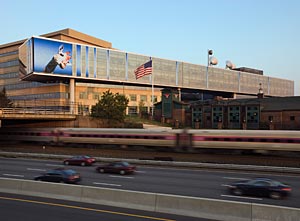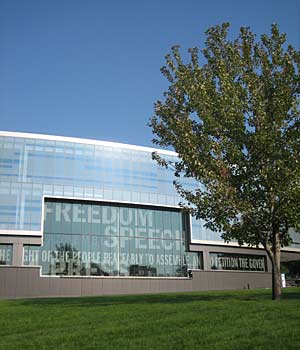Polshek Partnership Architects is spreading the news—literally. The Manhattan-based firm has designed three journalism-related projects featuring design elements that explicitly express the building’s program.


Designed by Polshek Partnership, the new headquarters for public broadcaster WGBH opens today in Brighton, Massachusetts. An oversized LED screen displays images from the station’s programs; slivers of LED screens punctuate the glazed facade of a long, rectangular volume that connects two other buildings in the three-building complex (top). Newhouse III, a new building for the S.I. Newhouse School of Public Communications at Syracuse University, will be dedicated on September 19. The text of the First Amendment is incorporated into part of the building’s glass curtain wall (above).
In its new headquarters for public broadcaster WGBH, Polshek created what it hopes will be an iconic moment along the Massachusetts Turnpike just outside Boston. The 310,000-square-foot complex opens today. It features a 30-foot-by-40-foot LED screen on the northern end of a 480-foot-long, office and production zone dubbed the “beam.” The screen cantilevers toward the heavily traveled road and can be seen from nearly two miles away. Each day it will display a single image taken from WGBH’s programs, such as Frontline and Nova. “You might see a picture from Mars one day and something microscopic the next,” says Richard Olcott, FAIA, partner at Polshek.
Strips of the LED screen punctuate the beam’s aluminum and glass curtain wall. The screen and strips are coplanar with the facade, creating what Polshek partner Tomas Rossant, AIA, describes as a digital skin: “We want to think of it as a skin that came alive rather than something tacked on as ornamentation.”
Polshek applied the same rationale in Newhouse III. This new 75,000-square-foot structure, which will be dedicated September 19, extends a mini-campus for the S.I. Newhouse School of Public Communications at Syracuse University. Its east facade, made of pre-cast concrete and fiber cement panels, matches the staid aesthetic of existing buildings by I.M. Pei and Skidmore, Owings and Merrill. In contrast, the west facade’s kinetic, sinuous form evokes old news tickers in Times Square. The ample use of glass along this elevation holds symbolism, Rossant says, because this material communicates transparency, a quality integral to journalism. And in one part of the facade, the text of the First Amendment is sandwiched between a double-layer glass curtain wall using tiny dots of white paint on a PVC sheet.
The First Amendment also figures in the facade of the Newseum, a 250,000-square-foot journalism museum in Washington, D.C., scheduled to open in early 2008. Here, though, the amendment text is engraved on a giant stone tablet.
While Polshek has no plans to focus exclusively on journalism projects, Rossant says that mixing media and architecture offers exciting possibilities. “As soon as you can integrate those two things together, you have a new type of architecture.”




Post a comment to this article
Report Abusive Comment